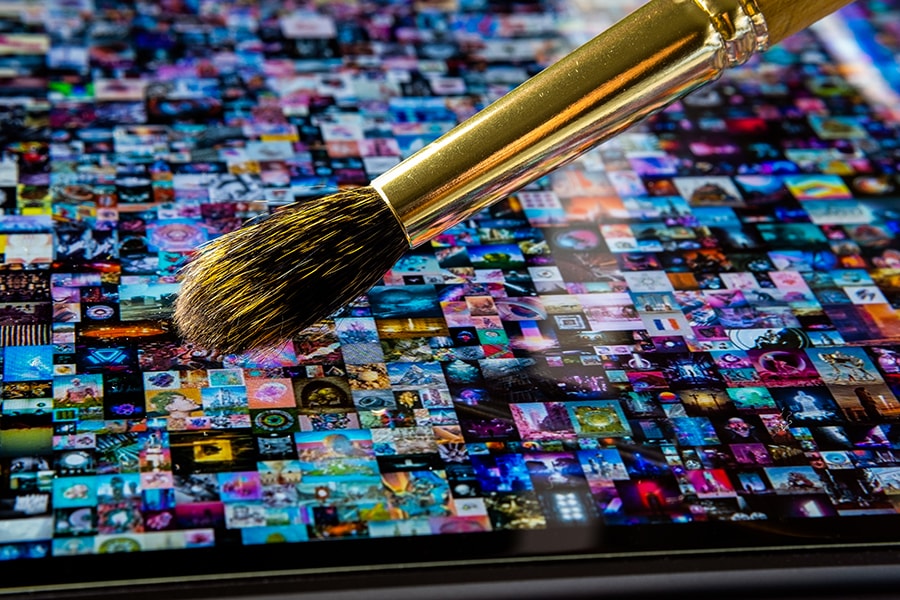My predictions for 2022 are a mixture of projection, prophecy and hope. But I do believe they will come true in some measure at least.
Not just individuals, but companies and brands will also see an uptick in originality and expressiveness. Creativity will, more than ever, become the fuel for the success of companies and brands in 2022. The more ubiquitous data and technology become, the more creativity will be the differentiator. Already, some of the most valuable companies, Apple, Netflix, and LVMH (which owns the Louis Vuitton brand) are differentiated by their innate creativity.
In 2022, we will see creativity as the differentiator for more companies, brands and individuals than ever before.
The term non-fungible token, NFT for short, will be on everyone’s lips in 2022In 2021 we saw the NFT for the American artist Beeple’s digital art titled ‘Everydays: The First 5000 Days’ sell for $69.3 million, a higher price than what paintings by masters like Salvador Dalà command. A previously unreleased song by the late Whitney Houston was also sold as an NFT for almost a million dollars. Closer home, Amitabh Bachchan’s NFTs, including one for the poetry of Madhushala recorded in his voice, went for a similar price.
And he’s not the only Indian to get on the NFT bandwagon. Stars Rajinikanth and Salman Khan and cricketing legend Sunil Gavaskar are among the others who have launched their own NFTs.
Brands have started experimenting with NFTs too. Pepsi has launched a collection of 1,893 pieces of NFT art, called the Mic Drop Genesis NFT, to commemorate the year of its birth, 1893. Nivea has tied up with artist Clarissa Baldassarri—who temporarily lost her vision at age 19—to offer her NFT art for free. The theme, appropriate to the brand, is about the value of touch. Many other brands are getting into NFTs and we will see an explosion of brand-related NFTs in 2022.
With non-fungible tokens on the rise, can fungible tokens be far behind? I am referring to cryptocurrencies, of course Indian authorities have talked about regulating or even banning cryptocurrencies, but no decision has been taken yet. India is one of the biggest crypto markets in the world. My guess is it will continue to grow in 2022—albeit within the strictures of a regulatory framework.
After all, how will we buy all that NFT art out there if our crypto wallets are empty?
In 2022, the Indian consumer will prefer sustainable brands
Environmental crusaders like the young Greta Thunberg and the nonagenarian Sir David Attenborough have made us all too aware of how the world is on the brink. And the fact that if we don’t act now, the window of opportunity to save the planet will shut forever.
Thanks to activists, crusaders and concerned citizens speaking out, public awareness about the sustainability crisis has been growing—with children educating parents in many instances.
The pressure from a more aware public will make corporates take sustainability more seriously in 2022. And it’s going to become a bigger criterion for brand choice.
There is an emerging willingness from consumers to pay a premium for sustainable products. Because they are realising that society and the environment pay too high a price for ‘cheaper’ products. Having said that, for sustainability to be sustainable, Indian brands will have to find cost-effective ways to produce sustainable products in the long run.
DEI—short for diversity, equity and inclusion—will become a more familiar abbreviation in 2022.
DEI means encouraging the representation and participation of diverse groups of people in the corporate world and society, at large. These diverse groups include people of different genders, sexual orientations, religions, cultures, ages, abilities, and disabilities.
At the organisational level, diversity has been compared to being invited to the dance and inclusion to being asked to dance. So, it’s about having a diverse workforce and making sure everyone’s voices are heard. Some companies will make efforts to bring DEI to their workplace. Others will extend it to their advertising and communication. We may not see a dramatic transformation in 2022, but definite strides will be taken in the right direction.
In advertising and communication, diversity and inclusion will mean going beyond tokenism. It will be about including humans of different backgrounds—not only in stories about diversity but also in brand stories in general.
In school, we learned that India stands for unity in diversity. Perhaps 2022 is the year we will give this idea contemporary relevance.
Those are my five predictions. Now let’s get busy turning them into reality. Happy 2022!
Sumanto Chattopadhyay is chairman and chief creative officer, 82.5 Communications, A WPP Company. Views are personal.

 Indian authorities have talked about regulating or even banning cryptocurrencies, but no decision has been taken yet. India is one of the biggest crypto markets in the world Image: Shutterstock
Indian authorities have talked about regulating or even banning cryptocurrencies, but no decision has been taken yet. India is one of the biggest crypto markets in the world Image: Shutterstock
